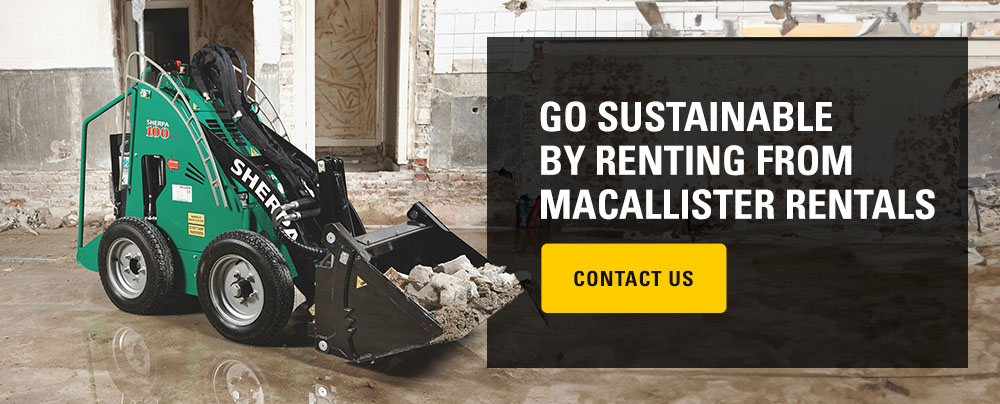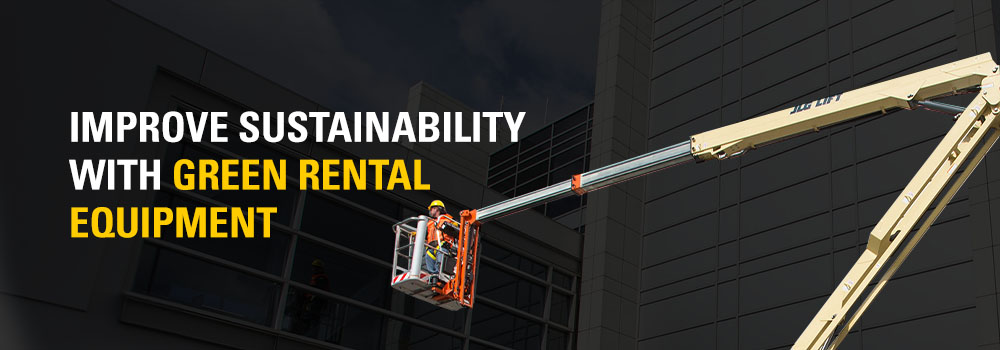
Construction jobs have multiple phases — site preparation, the foundation phase, the building phase and finishing with interiors and fittings. Each phase is unique and requires different tools. A drill, for example, is pretty useless when you are laying concrete. A concrete mixer is of no use when you are painting and putting the carpet down.
Renting makes a lot of sense when you are constructing in general. It allows you to get the tools and equipment you need when you need it, then return it when you finish the phase, then get the next lot. You don’t have to store the items in between or worry about maintenance. If something breaks down, you don’t have to wait for repairs. Simply communicate with the rental company, and they will give you another one.
For small or medium construction companies, it just makes sense. In fact, it makes a lot of sense for the larger construction companies, too, which is why they are also turning to renting. The European Rental Association, ERA) has acknowledged the movement and has changed the focus of its message from “ownership of goods” to “access of goods” to try and promote the change.
Renting has already proven itself to be beneficial in terms of time, as companies can take the equipment straight home. When purchasing equipment, lead times often require a waiting period. Renting also saves costs on maintenance and storage.
Jump to Section:
- Understanding Green Rental Equipment
- Benefits of Choosing Sustainable Equipment for Construction Projects
- Sustainability Considerations of Renting vs. Buying
- Go Sustainable By Renting From MacAllister Rentals
Understanding Green Rental Equipment
There is a difference between “green” and “sustainable.” A product or construction equipment that is green means it is environmentally friendly. Sustainability has a range of practices and principles that aim to meet the needs of the present, without compromising on the ability of the future. It focuses both on the environment of today and the resources for future generations.
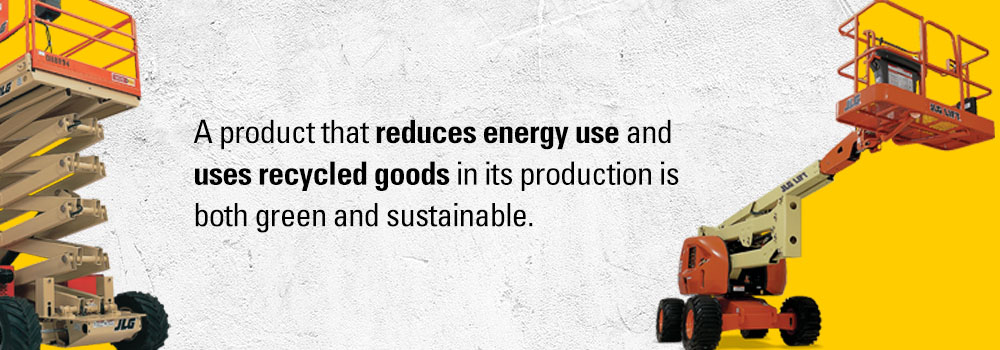
An example of a green product is one that reduces energy use. However, it isn’t ultimately sustainable if the production involves a large amount of coal burning or the product has a short life span. A product that reduces energy use and uses recycled goods in its production is both green and sustainable.
Renting equipment is a sustainable business practice because it reduces the production of new equipment. Using green rental equipment reduces your ecological footprint by conserving resources. If you want to increase your company’s sustainability, you should opt for electric rental equipment for indoor use rather than fuel-powered. Furthermore, you can optimize your equipment usage to the size of the job so you aren’t wasting fuel or electricity.
What Is Green Rental Equipment?
Now that you know the difference, let’s apply this to construction rental equipment. Here are a few features of green rental equipment:
- Electric and hybrid models: Just the same with cars, the industry is trying to move away from its reliance on fossil fuels. Some of the large equipment are still battling to find power sources for the amount they need, but you can definitely get smaller models, like forklifts, jackhammers and compaction tools that run on electricity.
- Use of eco-friendly fuels: If electricity isn’t an option, some equipment are turning to to using a fuel that is more eco-friendly, such as biodiesel. Most are not running 100% on eco-friendly fuels and are instead using a mix of 20% biodiesel and then 80% diesel fuel mix, but it is a start and a trend that will hopefully grow in the future.
- Energy efficiency: There are other ways to turn an engine green outside of tampering with the fuel options. You can install energy-efficient technologies, such as optimizing the engine and better aerodynamics to reduce fuel consumption.
- Emission controls: Newer models have a larger reduced output of harmful emissions than equipment made 10-20 years ago. The focus areas are pollutants like nitrogen oxides and particulate matter. The EPA has started creating regulations for heavy equipment with compression ignition or diesel engines to support the industry in reducing more and more emissions.
- Intelligent technologies: It isn’t easy to try and reduce emissions and increase efficiency when you can’t measure correctly. Smart technologies allow a system in which technicians and engineers can measure inputs and outputs accurately. The technologies also can allow for efficient use of equipment and reduce ideal times, further optimizing fuel usage.
Types of Green Rental Equipment Available
What kind of construction or heavy equipment can you start renting that is green? Here is an overview:
- Electric and hybrid: You can use a number of smaller heavy equipment which is battery-powered. They can be used for urban construction, material handling and indoor environments. There are electric mini excavators that are great for tight spaces, available in tracked or wheeled options. You can also get an electric scissor lift rental option. All the small equipment usually has a greener version if you ask.
- Solar panels: Generators are often needed for the first couple of months to power everything from lights to smaller tools. There are diesel and biodiesel options available, but if you are doing smaller jobs, another consideration is to get a solar-powered portable generator. For example, you can also get solar panels for temporary installation to power the on-site office trailer.
- Water-saving pressure washers: Water saving is also part of being greener and getting equipment that can use recycled water or that are water efficient is a step in the right direction. Pressure washers are often used on construction sites and can be easily changed out for greener options.
Benefits of Choosing Sustainable Equipment for Construction Projects
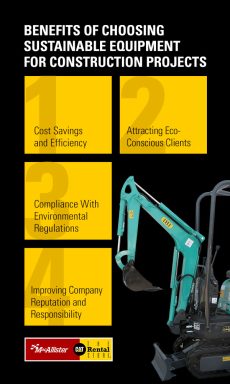 Green construction equipment reduces greenhouse gas emissions compared to traditional diesel-powered equipment. Lower gas emissions increase the air quality, but the equipment, in general, also make less noise. If you are doing a construction job indoors, these two things are already big benefits.
Green construction equipment reduces greenhouse gas emissions compared to traditional diesel-powered equipment. Lower gas emissions increase the air quality, but the equipment, in general, also make less noise. If you are doing a construction job indoors, these two things are already big benefits.
Energy efficiency is one advantage that is beneficial to both the environment and your costs. Fuel efficiency is another area that helps out the environment but also has economic benefits. All of these advantages also play a role in reducing the overall maintenance needs. Electric equipment typically has fewer moving parts, which lowers its need for a service.
But there are also social benefits, such as aligning the company with the green movement. The reduced emissions and noise pollution contribute to a healthier environment for workers and residents who live near the site.
1. Cost Savings and Efficiency
There are challenges to moving into the greening sector, with upfront costs. Installing advanced technologies and putting in insulation or energy-efficient applications does have an affect initially. But most of these can be picked up again in long-term savings as a lot of ongoing costs, such as energy, will be reduced with greener technology and savings.
There are also costs that can be saved in the beginning, which can also help with the initial demand. For example, using recycled aggregates or materials when constructing. Also, look to reuse terms and rent equipment were possible.
2. Attracting Eco-Conscious Clients
As the awareness for sustainability spreads, more clients are looking for ways to be part of the moment. By increasing your credibility as a greener practice, you can have leverage over your competitors by offering this specific clientele options that they can get behind.
3. Compliance With Environmental Regulations
Organizations that regulate the green movement for construction include
- The United States Environmental Protection Agency (EPA): The EPA is a federal agency that was established in the 1970s under President Nixon. The key functions and responsibilities include enforcing regulations on environmental laws. It works to ensure compliance among businesses, government entities and individuals. They also provide research and education on the subject to better inform professionals and the public.
- United Nations Environment Programme (UNEP): UNEP gathers and disseminates environmental data by assessing world conditions and trends. They developed international environmental agreements by working with each government in the implementation of the policies.
- International Green Construction Code (IgCC): The IgCC is part of a set of regulations known as the family of International Codes or I-Codes. It is developed by the International Code Council (ICC). The code has many features, but one that makes it unique is the encouragement of an integrative approach. It considers all the elements of a building design, construction, and operation work and how they work together to meet the sustainability goals.
4. Improving Company Reputation and Responsibility
Improving your company’s reputation and responsibility is a strategic move. Demonstrating your commitment to sustainability can enhance your brand image and expand your target audience. By complying with regulatory requirements and committing to green equipment practices, you can build a stronger relationship with your customers and even your employees.
When you position yourself as a leader in the movement to become more environmentally friendly, you can be ahead of the pack. Going green differentiates you from other companies and appeals to a slightly different market. It also has a positive effect on attracting investors and customers with similar mindsets. Naturally, customers want to associate with companies they can relate to or connect to through their values.
You can continue building your sustainable brand image by:
- Promoting transparency and reporting your sustainable efforts and progress as you grow it.
- Demonstrating your efforts through marketing and communications. Avoid going overboard and participating in greenwashing and stay genuine by showing your real efforts.
- Actively engaging with customers, employees, and so on regarding sustainability issues. They will create a positive perception and strengthen your brand loyalty.
- Adopting other eco-friendly practices such as using renewable energy, reducing construction waste and conserving resources.
- Following the supply chain and sourcing materials from ethical and sustainable locations and businesses. You can also get involved in the community and make a social impact by supporting local businesses.
Sustainability Considerations of Renting vs. Buying
There are benefits to renting over purchasing new equipment:
- Utilization: Rental equipment is generally more efficient as it is shared. Instead of five companies having their own equipment, there is one piece of equipment for all five, so fewer resources are needed for production. This also works at the end of the life span. The amount of old or unused equipment is also reduced in landfills as there are fewer. A lot of rental companies also have recycled processes.
- Obsolescence: As five companies are all using one piece of equipment, that equipment is in constant use and, therefore, works through its life span quicker. Rental companies are able to update their fleet regularly, allowing for the latest models to become available.
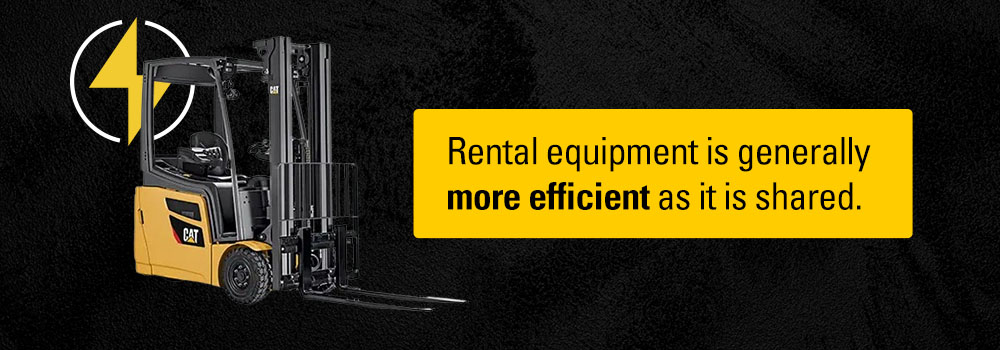
You also have the option to purchase used equipment. Buying used equipment is a great middle ground with many benefits:
- Resource efficiency: Using equipment completely to the end of its life span maximizes efficiency.
- Waste reduction: Rental companies keep their equipment in good working condition, performing regular service and maintenance. If you are going to buy used equipment, getting one from a rental company may be the best deal. They will keep the equipment’s maintenance records in order, and you can trust them to provide professional repairs every time.
- Lowering carbon footprint: Buying rental equipment is definitely a sustainable option. You are reducing emissions by purchasing equipment that has already been made and has been in use, avoiding making new equipment from scratch.
- Cost saving: Secondhand equipment will be a cost-saving option over buying new, allowing you to use your finances elsewhere in your business. Getting from a rental company is even better as they would ensure the equipment was well-maintained and have invested in it.
Go Sustainable By Renting From MacAllister Rentals
The MacAllister company has long been a family-owned business where we aim to offer first-class service and top-notch rentals. We have over 50 manufacturers at our disposal, including all the favorites from Cat®, Genie, JLG, SHERPA and many more. Our impressive selection of earthmoving, agricultural and construction equipment, with an outstanding maintenance reputation, can be rented at affordable rates. If you are looking for something long-term or have fallen in love with the equipment you rented, then chat with us about buying our rented equipment.
Sometimes, you don’t need the large, heavy equipment, but just the attachments and tools for a specific job. Perhaps you also want to try a tool out for a project before you invest in one. We rent all of those as well, including the smaller equipment like jackhammers, lasers and concrete saws.
We have a three-prong approach when finding solutions for our clients;
- Offer high-class customer service from beginning to end.
- Have options for our clients in terms of versatile brand offerings and inventory for parts and equipment.
- We also have a large coverage with lots of locations.
If these are the values you are looking for with a company to partner with, on your rental equipment, then contact us online or find a location in your area.
